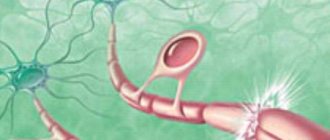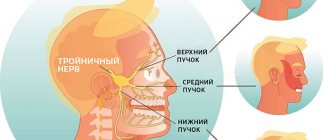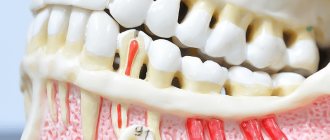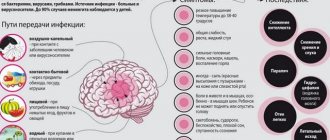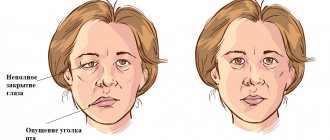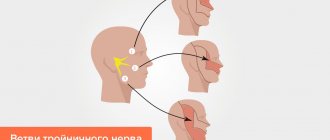Neurologist (algologist)
Vasilenko
Marina Gennadievna
Experience 26 years
Head of the Pain Treatment Center, neurologist-algologist, member of the Society of Neurologists and Neurosurgeons, Russian Society for the Study of Pain, Association of Interdisciplinary Medicine, International Association for the Study of Pain (IASP)
Make an appointment
The trigeminal nerve is the largest of the 12 cranial nerves, specifically their fifth pair. It belongs to the nerves of a mixed type and includes very sensitive fibers. This name is due to the fact that the nerve is divided into three branches, providing mobility and sensitivity of the face, mucous membranes of the mouth and teeth. These are the ophthalmic, maxillary and mandibular branches.
Inflammation of the trigeminal nerve is a serious pathology that causes severe pain in the facial area. Otherwise it is called neuritis. In turn, neuralgia is pain along the trigeminal nerve. It can act as an independent sensitivity disorder, but it often accompanies inflammation, i.e. neuritis.
Symptoms and signs
Acute trigeminal neuralgia causes sudden and very severe pain along the nerve fiber. It manifests itself in attacks and is shooting and burning in nature. On average, the duration of an attack is up to 3 minutes; in approximately 7% of patients it lasts up to 3 days. Their number can reach 200 per day.
Pain from trigeminal neuralgia can be observed in different parts of the face. It all depends on which branch of the nerve was affected:
- if maxillary - in the area of the facial muscles, upper jaw and nose.
- mandibular – the pain will resemble a toothache.
- ophthalmic – in the area of the temples, forehead and above the eyebrows.
Against the background of pain, the patient develops increased anxiety and even phobias. A person strives to avoid those poses and movements that provoke unpleasant sensations in him. Other characteristic symptoms of inflammation of the trigeminal nerve:
- facial muscle spasms;
- increased salivation;
- increased or decreased sensitivity of facial skin;
- moderate increase in temperature;
- weakness and muscle pain.
Are you experiencing symptoms of trigeminal neuralgia?
Only a doctor can accurately diagnose the disease. Don't delay your consultation - call
Publications in the media
Trigeminal neuralgia (TN) is a disease characterized by paroxysms of severe facial pain in the innervation zones of one or more branches of the trigeminal nerve, often provoked by touching the skin of the trigger zones. Trigger zones are areas of the skin of the lips, nasolabial folds, wings of the nose, eyebrows, a light touch of which provokes an attack of pain, and strong pressure eases the developed pain attack. Frequency - 16:100,000. The predominant age is over 40 years, the peak incidence is 60 years, women get sick more often.
Etiology • The most common cause is compression of the trigeminal nerve by the arteries or veins of the posterior cranial fossa, a vascular loop in the presence of vascular anomalies • The branches of the trigeminal nerve passing through the bone canals can also be subjected to compression (narrowing of the latter can be caused, for example, by chronic inflammatory processes in adjacent areas - caries, sinusitis) • In rare cases, the disease is caused by tumors of the cerebellopontine region (for example, meningioma) or the fifth pair of cranial nerves, multiple sclerosis.
Pathogenesis • Damage to the peripheral segment of a nerve - a branch or root • Under the influence of the compression factor and prolonged subthreshold irritation, an easily excitable neural system appears in the brain.
Clinical picture • Short (up to 1–2 min) paroxysms of intense pain in the cheek, upper and lower jaw, less often in the eyebrow, pain is predominantly unilateral (less than 4% - bilateral) •• Presence of trigger zones •• Eating, talking, cooling provokes a painful attack •• Soreness of the exit points of the branches of the trigeminal nerve (supraorbital, infraorbital and mental points) •• The lesion is usually limited to one or two branches (usually the maxillary and mandibular) of the trigeminal nerve •• No signs of loss of sensitivity in the area of pain.
• Additional characteristics •• Symptoms are rarely expressed at night •• Pain syndrome occurs more often on the right •• Painful tic (wrinkling of the face in pain) •• Redness of the face •• Lacrimation •• Salivation •• Burning •• Pain lasts several seconds followed by a pain-free period .
Special research methods • MRI or CT can exclude tumors of the cerebellopontine region. Differential diagnosis • Other forms of neuralgia (eg, glossopharyngeal nerve) • Tumors of the cerebellopontine region • Abnormalities of vascular development in the brain stem • Demyelinating diseases • Chronic meningitis.
TREATMENT Management tactics • Determination of the etiology of the pain syndrome (examination of ENT organs, dental examination) • After diagnosis, drug therapy is indicated; in case of ineffectiveness, surgical treatment is performed (usually after 3-4 weeks).
Drug therapy • The drug of choice is carbamazepine 400–1200 mg/day. During treatment, it is necessary to periodically examine liver function and conduct blood tests. The drug is contraindicated in the first 3 months of pregnancy • Second-line drugs •• Phenytoin 300–600 mg/day •• Baclofen 10–80 mg/day; start with 5–10 mg 3 times a day (as an adjuvant therapy with phenytoin or carbamazepine) •• Amitriptyline or trazodone before bedtime (or in small doses during the day) •• Valproic acid.
Surgical treatment • Microsurgical decompression of the V pair of cranial nerves at their exit from the brainstem (effective in 73% of cases) • Partial sensory rhizotomy • Peripheral blockade or transection of the V pair of cranial nerves proximal to the Gasser ganglion • Peripheral destruction of the nerve •• Neurectomy •• Cryosurgical methods • • Diathermocoagulation •• High-frequency radiation.
Course and prognosis • Exacerbations in autumn and spring • In the absence of relapses, the prognosis is good • In 70% of cases, it is possible to eliminate the pain syndrome by taking carbamazepine.
Synonyms • Painful tic • Trigeminal neuralgia • Fothergill's disease. Reduction. NTN - trigeminal neuralgia
ICD-10 • G50.0 Trigeminal neuralgia
Causes and risk factors
Neuralgia of the trigeminal nerve branch is a disease with many possible causes. First of all, this is compression by vessels: displaced arteries or veins. Inflammation can also be provoked by metabolic disorders and diseases that are associated with them. These are diabetes mellitus, gout and other similar pathologies.
There are other possible causes of trigeminal neuralgia:
- inflammations that occur during dental treatment;
- hypothermia (general or facial area);
- mental disorders;
- purulent diseases of the jaw bones or skull;
- infection of the body with worms;
- chronic caries or sinusitis;
- infectious and viral diseases (herpes, adenoviruses, mumps, pulmonary tuberculosis, herpes zoster);
- very severe allergies;
- brain tumors;
- inflammation of the outer, middle or inner ear;
- multiple sclerosis;
- too narrow canal of the facial nerve from birth;
- injuries or operations on the temporal bone.
Causes
Unlike neuritis, neuralgia is not an inflammatory disease. Fever, fever, swelling and other symptoms of the inflammatory process are not associated with this disease. However, if the trigeminal nerve is damaged due to neuritis, pain sensations that fit the description of neuralgia may well occur. To avoid confusion and differentiate the two pathologies, it is necessary to consider their etiology.
The cause of neuritis (like any other inflammatory disease) is viruses and infections that cause gradual destruction of the membrane and nerve trunk, and classical neuralgia in the vast majority of cases occurs due to mechanical effects on the nerve. Today, experts identify dozens of factors that provoke the development of the disease.
Main causes of neuralgia
- Head injuries leading to changes in the cranial structure and displacement of bones.
- Benign and malignant tumors that, as they grow, compress the trigeminal nerve.
- Various bite pathologies and other dental anomalies.
- Pathologies of the structure and diseases of blood vessels located in close proximity to the nerve (atherosclerosis, aneurysm, vasodilatation, etc.).
- Sinusitis and otitis in chronic form.
- Trigeminal neuralgia after tooth extraction. Occurs during a traumatic or incorrectly performed extraction procedure.
- Damage as a result of infection resulting from a number of diseases: periodontitis, periodontitis, stomatitis, herpes, syphilis.
Trigeminal neuralgia from hypothermia occurs rarely. However, this factor contributes to the development of the disease and complicates treatment. The same can be said about decreased immunity, metabolic disorders, neurosis, diabetes and other complicating factors.
Possible complications
Over time, symptoms of inflammation of the trigeminal nerve can give rise to neuropathic complications and lead to the development of secondary pain syndrome in the head. In the chronic form of the disease, the auditory and facial nerves are irritated. Without treatment, trigeminal neuralgia can lead to more serious complications:
- dystrophy of masticatory muscles;
- decreased sensitivity of the affected area;
- Sykinesia (cooperative movements in which one nerve controls many muscles);
- contracture and spontaneous contraction of the facial muscles;
- conjunctivitis.
Diagnosis of the disease
It is done using:
- Palpation of the area. Initially, the doctor feels the area of nerve endings.
- MRI. Usually, if inflammation of the trigeminal facial nerve is suspected, the specialist will prescribe magnetic resonance imaging of the brain.
- Angiography. Another diagnostic method is magnetic resonance angiography. It will allow you to see whether the anterior inferior cerebellar artery is dilated. It can put pressure on and irritate the trigeminal nerve.
- X-ray of the skull and paranasal sinuses. Abnormalities may be detected, such as narrowing of the channels through which the nerve passes.
It is important to remember that if the first symptoms are detected, you must immediately contact a specialized medical institution and not resort to treatment with folk remedies. Otherwise, the initial inflammatory process may develop into a chronic disease.
Treatment options for trigeminal neuralgia
Classical therapy requires hospital conditions. Therefore, the patient is hospitalized in the hospital, where he remains until the end of treatment for inflammation of the trigeminal nerve. The patient can be discharged after severe pain has been eliminated and muscle spasm has been relieved. The doctor can transfer the patient to a day hospital or to home treatment.
Drug treatment involves pain relief - novocaine-alcohol blockade, sometimes a stronger painkiller is used and a reduction in local edema. To relieve swelling, doctors prescribe antispasmodics, glucocorticoids (prednisolone) and non-steroidal anti-inflammatory drugs. Glycerin injections show good results in the treatment of inflammation of the trigeminal facial nerve.
To relieve the pathological process, medications are prescribed that stimulate the renewal and nutrition of nerve fibers. The main thing to remember is that medications in each case should be recommended by the attending physician.
If therapeutic treatment does not help, then it is replaced by surgical intervention. Today there are several invasive ways to combat inflammation of the trigeminal nerve:
- radiosurgery. This is a method using ionizing radiation. You will not need pain medication during radiosurgery. Moreover, after the operation you will not have any scars;
- decompression. During surgery, the surgeon will remove or displace the vessels that are compressing the trigeminal nerve. It is indicated for those who have congenital anomalies. However, the method is fraught with possible side effects such as stroke or hearing loss and sensitivity.
Treatment of trigeminal neuralgia using MDM therapy
This is a modern physiotherapeutic method based on electrical stimulation effects on the structures of the midbrain.
In the early stages of the disease, electrical stimulation eliminates pain in 1-2-3 sessions. During another 4-7 sessions, the inflammation goes away completely. MDM therapy will also help cope with chronic inflammation. If a disease of the trigeminal nerve occurs as a complication of the underlying disease, then more than one course may be needed for a complete cure.
Advantages of the technique
Treatment of chronic diseases. The MDM therapy method will help to significantly boost immunity and increase the body's resistance in stressful situations.
Analgesic effect. After the first procedure, MDM therapy allows you to reduce the intake of analgesics, and then completely abandon them.
Rapid restoration of nerve fibers and tissues. The method can be successfully combined with invasive treatment methods. It accelerates regeneration processes. In addition, MDM therapy has a positive effect on neurogenesis.
Increasing the effect of drug treatment. If you have a chronic form of inflammation of the trigeminal nerve, then MDM therapy can increase the effectiveness of the drugs.
You can undergo a course of such treatment only in some medical institutions in the capital. The Happy Family clinic is one of them.
When to see a doctor
If you experience symptoms of trigeminal neuralgia, you should immediately consult a doctor, as it may be a sign of another serious disease. In the treatment of neurological pathologies, accurate and timely diagnosis is extremely important. This is done by a neurologist, with whom you can make an appointment at our clinic in the center of Moscow. The specialist knows not only how to relieve trigeminal neuralgia, but also how to correctly diagnose it in order to prescribe effective treatment in the future.
Diagnosis of trigeminal neuralgia
A preliminary diagnosis can be made by a neurologist based on the patient’s complaints, studying the history of his disease and an objective examination of the face with an assessment of symmetry at rest and when trying to smile. Also, during the consultation, the doctor may conduct additional tests, asking the patient to close his eyes, purse his lips, frown, etc.
Laboratory and instrumental diagnostics of trigeminal neuralgia include the following examinations:
- general blood and urine tests;
- computed tomography (CT) and magnetic resonance imaging (MRI);
- radiography of the paranasal sinuses;
- panoramic radiography of the oral cavity;
- electroneuromyography to determine the localization of inflammation.
Treatment
Treatment of inflammation of the trigeminal nerve is carried out depending on the severity of symptoms. First, conservative therapy is prescribed. If this does not help, doctors resort to surgical methods. Their essence is to eliminate the cause of neuralgia. This may be compression of the nerve by the vessel. Surgical treatment is carried out using radiofrequency destruction, microvascular decompression or percutaneous surgery.
What drugs are most effective for the treatment of trigeminal neuralgia:
- antibiotics. Prescribed for infectious nature of the disease;
- glucocorticosteroids. Relieves severe inflammation in the body;
- non-steroidal anti-inflammatory drugs (NSAIDs). Helps suppress inflammatory processes;
- painkillers. Relieves soreness in the facial muscles;
- muscle relaxants.
To improve metabolic processes in the nervous tissue, the patient is prescribed B vitamins. How to relieve acute pain with trigeminal neuralgia:
- use anticonvulsants;
- provide physical rest, preferably bed rest;
- Apply an anti-inflammatory ointment or a warm compress to the site of pain.
Clinical manifestations of neuralgia
Trigeminal neuralgia is characterized by facial pain, which usually comes on suddenly.
- The pain may be severe, shooting, and feel like an electric shock.
- Pain may occur after touching the face, while chewing, talking, or brushing teeth.
- The duration of the attack of pain reaches several seconds.
- Severe pain in the facial area can be prolonged (for several days, weeks).
- The pain spreads to those areas of the face that are innervated by the trigeminal nerve - the lower jaw, cheek, gums, lips, and sometimes the eye or forehead area.
- Usually the pain is one-sided.
- The frequency of pain attacks varies from single to tens and hundreds per day.
- During the period of exacerbation, more often in the cold season, attacks become more frequent.
- Over time, without treatment, attacks of pain become more frequent and their intensity increases.
Pain syndrome can be typical and atypical:
- typical - the pain either subsides or intensifies; shooting pain, even touching the face can provoke it;
- atypical - the pain does not subside, and as a result it seems to the patient that half of his face hurts; he cannot accurately indicate the location of the pain.
Sometimes trigeminal neuralgia is accompanied by twitching of facial muscles (painful tic) and autonomic disorders (redness of the face, lacrimation, drooling, nasal congestion). Pain, as a rule, forces patients to immediately consult a neurologist.
Home remedies
Before treating trigeminal neuralgia at home, you should consult a doctor, since many remedies can only worsen the situation. If the specialist allows it, it is also possible to use various home recipes.
According to recommendations for trigeminal neuralgia, it is worth consuming orally or lubricating the affected side with birch sap. You need to drink 4-5 glasses per day. Heated buckwheat folded in cotton cloth will help relieve pain. The compress is made 2 times a day, keeping it at the site of inflammation until it cools down. At home, it is useful to massage the sore area: rub, stroke and lightly knead the area of inflammation.
Myths and dangerous misconceptions in treatment
Due to the fact that neuralgia does not affect the general condition of the body, many patients postpone visiting a doctor and treating the trigeminal nerve. In fact, this is the wrong approach, since the disease can lead to paralysis and muscle paresis. In addition, it has a significant impact on psychological and social aspects of life.
No less important is the fact that painkillers for trigeminal neuralgia provide only a temporary effect. Over time, anticonvulsant medications may also stop working as they become addictive. Therefore, you should not abuse medications. They only relieve the symptoms of neuralgia, and its cause can only be identified by a qualified specialist.
Treatment of neuralgia
Treatment of neuralgia is a long and difficult process, but doctors at the CELT Pain Clinic know how to carry it out with maximum positive effect. For this, two treatment methods are used.
Conservative method of treating neuralgia
Conservative treatment involves taking medications:
- antispasmodics;
- anticonvulsants;
- non-steroidal anti-inflammatory drugs;
- glucocorticoids;
- anticholinesterase drugs;
- antidepressants;
- vitamins
It is very important to correctly calculate the dosage of medications (this is done by the doctor) and take them regularly (this is the patient’s function), since this is the only way to achieve the desired effect. In complex conservative therapy, physiotherapeutic methods of treatment - Bernard currents - help to achieve a good effect; acupuncture; paraffin applications, etc.
If conservative therapy does not bring the desired effect, the attending physician may decide on surgical treatment.
Surgical method for treating neuralgia
The following surgical treatment methods have proven themselves well:
- microvascular decompression of the root using implants that prevent compression on the nerve;
- radiofrequency destruction, which involves destruction of the nerve root;
- stereotactic radiosurgery (implies a targeted impact on the pathological focus with ionizing treatment using Gamma Knife and CyberKnife devices);
- balloon compression (carried out without violating the integrity of the skin) - a conductor with a balloon at the end is inserted into the area of the trigeminal nerve ganglion using a special needle. By inflating the balloon, the doctor compresses the nerve, which leads to its destruction and cessation of pain impulses.
In any case, the key to successful treatment is timely consultation with a doctor. Contact the CELT clinic, our specialists are always ready to help and relieve you of pain!
Make an appointment through the application or by calling +7 +7 We work every day:
- Monday—Friday: 8.00—20.00
- Saturday: 8.00–18.00
- Sunday is a day off
The nearest metro and MCC stations to the clinic:
- Highway of Enthusiasts or Perovo
- Partisan
- Enthusiast Highway
Driving directions
Prevention
There is no specific prevention against neuralgia. Doctors only recommend eliminating as much as possible exposure to the body of those risk factors that can lead to nerve inflammation. To avoid this, it is necessary to prevent hypothermia of the face, especially in the summer when using fans and air conditioners. It is important to harden yourself and worry less in order to reduce the impact of stress. It is also imperative to treat underlying diseases that are risk factors for neuralgia.



